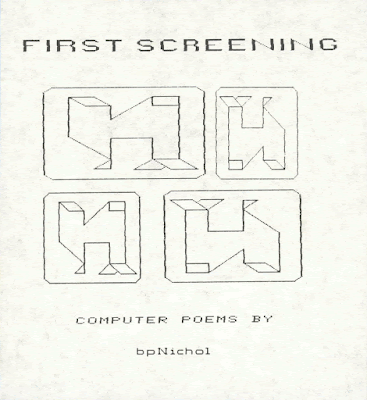Steve McCaffery in his book titled Rational Geomancy: The Kids of the Book-Machine suggests that book is like a machine (p.60). The machine, according to him, stores information by arresting the flow of the speech conveying that information. It has capacity to alter function and affect the content of the fictional reality presented. When we apply this theory to bpNichol’s First Screening, his masterpiece, then, appears as a machine that provides a dozen of programmed and kinetic poems — only it is not in a form of book but in a metadata using Apple Ile. Its poems are displayed in an experimental presentation that was considered new when it was made.
When I opened First Screening using the Apple IIe emulator which is closest to the original data, I could not determine the sequential arrangement of the pages. The interface appears as if it is a unity of poems being continuously played and the only chance for me to stop reading is by pausing. When I paused, that is the only time for me to ‘breathe’ from reading and to comprehend the information given by these poems. If a machine that is in a form of a book or printed material works by picking up the book, opening the cover, reading it, and flipping through pages; then this piece by bpNichol (using the Apple IIe emulator) works by loading the file, reading, and pausing if necessary.
One of the poems in First Screening that caught my attention is “Contruction One”. This specific poem contains only two words which are ‘tower’ and ‘babel’. These two words are animated on screen into a visual that demonstrates construction as suggested by its title. The emulator displays the word tower that is being built into the image of a real tower, and by this, the readers are invited to build the tower with the word as well. When the readers read the first ‘tower’ word into the next ones, they are also building the image of the tower in their head—besides it being displayed on screen. Besides ‘tower’, the word ‘babel’ is also repeated and filled into the screen, which represents confused noise found in construction sites. In this poem, the readers and bpNichol through the screen are merging into simply a rhythmic process. BpNichol did not merely presenting a subject, but he is also inviting the readers to build the visual in their mind. The poem presents repetition of the two words and serves meanings by turning it into a visual. Through the animated visual, there is displayed a text that is not static, but moving into the image of what is represented. This repetition of words, according to McCaffery, is called as insistence, which “means the words that would be the same but each writing would be a unique transciption” (85).
Note: You can access bpNichol's First Screening on http://vispo.com/bp/introduction.htm. To play the poem using the Apple IIe emulator, simply click the "Emulator Version" on the menu bar and follow the instruction. I highly recommend you experience reading bpNichol's poems by using this emulator. It feels really fascinating! You can also browse bpNichol's historiography on the website. Enjoy!


